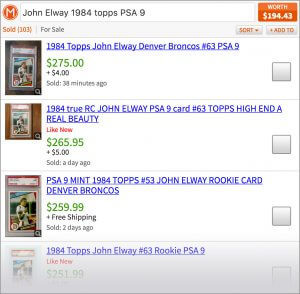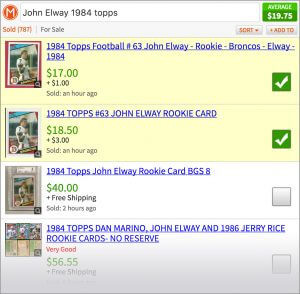Finding the value of your football cards can be an exciting journey, whether you’re a seasoned collector or just starting out. Determining the accurate value requires a blend of research, understanding market trends, and knowing where to look. This guide provides detailed steps and resources to help you assess your cards’ worth effectively.
1. Identifying Key Factors That Influence Football Card Value
Several factors play a crucial role in determining the value of football cards. Understanding these elements is the first step in accurately assessing your collection.
1.1. Condition of the Card
The condition of a football card significantly impacts its value. Cards are typically graded on a scale from 1 to 10, with 10 being a “Gem Mint” condition. Grading companies like PSA (Professional Sports Authenticator) and BGS (Beckett Grading Services) assess cards based on factors such as:
- Centering: How well the image is aligned on the card.
- Corners: Sharpness and absence of wear.
- Edges: Smoothness and lack of chipping or fraying.
- Surface: Absence of scratches, creases, or stains.
According to PSA, a card in “Mint” condition (Grade 9) can be worth significantly more than the same card in “Excellent” condition (Grade 5 or 6). For example, a 1986 Jerry Rice Topps card graded PSA 9 might fetch several hundred dollars, while the same card in a lower grade might only be worth $20-$50.
1.2. Rarity and Scarcity
Rarity refers to how many of a particular card were originally produced. Limited edition cards, short prints, and error cards tend to be more valuable due to their scarcity.
- Limited Edition Cards: These cards have a pre-determined, limited print run, making them inherently rarer.
- Short Prints (SP): Cards that were printed in smaller quantities compared to the base set.
- Error Cards: Cards with printing mistakes or incorrect information can become highly sought after by collectors.
1.3. Player Popularity and Hall of Fame Status
Cards featuring popular players, especially those inducted into the Pro Football Hall of Fame, typically command higher prices. Collectors are often willing to pay a premium for cards of iconic players like Tom Brady, Walter Payton, or Joe Montana.
For example, a Tom Brady rookie card can be worth thousands of dollars, especially if it’s in excellent condition and graded by a reputable company. Hall of Fame players provide long-term value due to their lasting legacy in the sport.
1.4. Card Type and Set
The type of card and the set it belongs to also affect its value. Rookie cards, autograph cards, and memorabilia cards (containing pieces of game-worn jerseys or equipment) are generally more valuable than base cards.
- Rookie Cards: The first cards featuring a player are highly prized, especially if the player becomes a star.
- Autograph Cards: Cards signed by the player are popular among collectors, with on-card autographs being more desirable than sticker autographs.
- Memorabilia Cards: These cards contain pieces of game-used items, adding a unique element of collectibility.
 Screenshot showing worth of graded football card.
Screenshot showing worth of graded football card.
1.5. Grading and Authentication
Having a card professionally graded and authenticated by a reputable company can significantly increase its value. Grading companies like PSA, BGS, and SGC (Sportscard Guaranty Corporation) assess the card’s condition and authenticity, providing a standardized grade that collectors trust.
A high grade from a reputable company assures potential buyers of the card’s quality and authenticity, making it more attractive and valuable.
2. Step-by-Step Guide to Finding Football Card Values
Now that you understand the key factors, here’s a detailed guide on how to determine the value of your football cards.
2.1. Gather Card Information
Before you start your research, gather all relevant information about your card. This includes:
- Year: Look for the copyright date on the back of the card.
- Brand: Identify the card manufacturer (e.g., Topps, Upper Deck, Panini).
- Player Name: Note the full name of the player featured on the card.
- Card Number: Locate the card number, usually found on the back.
- Condition: Assess the card’s condition based on the criteria mentioned earlier (centering, corners, edges, surface).
- Any Special Features: Note if the card is a rookie card, autograph card, memorabilia card, or has any other special features.
2.2. Utilize Online Price Guides and Databases
Several online resources can help you determine the value of your football cards. These platforms compile sales data and provide estimates based on various factors.
2.2.1. MAVIN
MAVIN is a search engine specifically designed for sports card values. You can enter the card’s details, and MAVIN will provide recent sales data from online marketplaces like eBay.
- How to Use MAVIN:
- Visit the MAVIN website.
- Enter the year, brand, player name, and card number.
- Review the search results to find comparable cards.
- Use the checkboxes to select similar “comps” and get an average price.
MAVIN is particularly useful for getting a quick estimate of your card’s value based on recent sales data.
2.2.2. eBay Sold Listings
eBay can be a valuable resource for determining card values. By searching for completed listings, you can see what similar cards have actually sold for.
- How to Use eBay Sold Listings:
- Go to eBay and enter the card’s details in the search bar (e.g., “1986 Topps Jerry Rice Rookie Card”).
- Filter the search results by “Sold Listings” to see completed sales.
- Analyze the prices of similar cards in comparable condition.
Keep in mind that eBay prices can fluctuate based on demand and auction dynamics, so it’s important to look at multiple listings to get an accurate picture.
2.2.3. PSA and BGS Price Guides
PSA and BGS offer online price guides that provide values for graded cards. These guides are based on historical sales data and expert analysis.
- How to Use PSA and BGS Price Guides:
- Visit the PSA or BGS website.
- Navigate to their price guide section.
- Enter the card’s details, including the grade if it’s been graded.
- Review the estimated value based on the grade and recent sales data.
These price guides are particularly useful if you have graded cards or are considering getting your cards graded.
2.3. Consult with Card Dealers and Experts
If you’re unsure about the value of your cards, consider consulting with experienced card dealers or collectors. They can provide expert opinions based on their knowledge of the market.
- Local Card Shops: Visit local card shops and ask for their opinion on your cards’ value.
- Card Shows: Attend card shows and talk to dealers and collectors.
- Online Forums and Communities: Join online forums and communities dedicated to sports card collecting and ask for advice.
Remember that dealers may offer wholesale prices if you’re looking to sell, as they need to make a profit.
2.4. Consider Professional Grading
If you believe your card is in excellent condition, consider getting it professionally graded by PSA, BGS, or SGC. A high grade can significantly increase the card’s value.
- How to Get a Card Graded:
- Research the grading companies (PSA, BGS, SGC) and choose one that fits your needs.
- Prepare your card for submission by placing it in a protective sleeve and holder.
- Fill out the grading company’s submission form and pay the grading fee.
- Send your card to the grading company.
- Wait for the grading company to assess your card and assign a grade.
Once you receive the graded card, you can use the grade to determine its value using online price guides or by consulting with dealers.
 Screenshot showing checkboxes for value of football card
Screenshot showing checkboxes for value of football card
3. Understanding Market Trends and Fluctuations
The football card market can be influenced by various factors, including player performance, media coverage, and economic conditions. Staying informed about these trends can help you make informed decisions about buying or selling cards.
3.1. Player Performance
A player’s performance on the field can significantly impact the value of their cards. A breakout season or a major achievement can lead to a surge in demand and prices.
For example, if a rookie quarterback has an outstanding season, their rookie cards will likely increase in value. Conversely, if a player’s performance declines or they suffer an injury, their card values may decrease.
3.2. Media Coverage
Media coverage, including news articles, documentaries, and social media buzz, can also influence card values. Positive media attention can increase demand and prices, while negative coverage can have the opposite effect.
3.3. Economic Conditions
Economic conditions, such as recessions or periods of economic growth, can also affect the sports card market. During economic downturns, people may be less willing to spend money on collectibles, leading to lower prices. Conversely, during periods of economic growth, demand for sports cards may increase.
3.4. Collectible Market Trends
The overall collectible market can influence sports card values. Trends in other collectible areas, such as comic books or vintage toys, can sometimes spill over into the sports card market. Staying informed about these broader trends can help you anticipate changes in the football card market.
4. Tips for Maximizing the Value of Your Football Cards
Here are some tips to help you maximize the value of your football cards:
4.1. Protect Your Cards
Proper storage and handling are essential to maintaining the condition of your cards. Use protective sleeves and holders to prevent damage from dust, moisture, and handling.
- Sleeves: Place each card in a soft, acid-free sleeve to protect the surface from scratches.
- Toploaders: Insert the sleeved card into a rigid toploader for added protection.
- Binders: Store cards in binders with acid-free pages.
- Storage Boxes: Use专门设计的存储盒,以保护您的卡免受损坏。
4.2. Keep Up with Market Trends
Stay informed about the latest market trends by reading industry publications, following online forums, and attending card shows. This will help you make informed decisions about buying, selling, and grading cards.
4.3. Consider Grading High-Value Cards
If you have cards that you believe are in excellent condition, consider getting them graded by a reputable company. A high grade can significantly increase the card’s value and make it easier to sell.
4.4. Be Patient
The value of football cards can fluctuate over time, so it’s important to be patient. If you’re looking to sell, wait for the right opportunity to maximize your return. If you’re collecting, enjoy the hobby and don’t get too caught up in short-term price fluctuations.
5. Common Mistakes to Avoid When Valuing Football Cards
Valuing football cards can be complex, and it’s easy to make mistakes. Here are some common pitfalls to avoid:
5.1. Overestimating Condition
Many collectors overestimate the condition of their cards. Be honest and objective when assessing condition, and consult with experts if you’re unsure.
5.2. Ignoring Market Trends
Failing to stay informed about market trends can lead to inaccurate valuations. Always research recent sales data and consult with experts to get an accurate picture of your cards’ value.
5.3. Relying on Outdated Price Guides
Price guides can become outdated quickly, so it’s important to use the most current information available. Always check recent sales data and consult with experts to ensure your valuations are accurate.
5.4. Neglecting to Protect Cards
Improper storage and handling can damage cards and reduce their value. Always use protective sleeves and holders to prevent damage.
6. Resources for Further Research
For those looking to delve deeper into the world of football card collecting and valuation, here are some valuable resources:
6.1. Sports Card Market Report
The Sports Card Market Report provides in-depth analysis of market trends and prices. This report is a valuable resource for serious collectors and investors.
6.2. Beckett Marketplace
Beckett Marketplace offers a wide range of resources, including price guides, articles, and forums. This is a great place to connect with other collectors and learn about the hobby.
6.3. PSA CardFacts
PSA CardFacts provides detailed information about specific cards, including historical sales data, population reports, and expert analysis. This is a valuable resource for researching individual cards.
6.4. Online Forums and Communities
Online forums and communities, such as Blowout Cards and Sports Card Forum, are great places to connect with other collectors, ask questions, and share information.
7. Conclusion
Finding the value of football cards involves a combination of research, understanding market trends, and consulting with experts. By following the steps outlined in this guide, you can accurately assess the value of your cards and make informed decisions about buying, selling, and collecting. Remember to protect your cards, stay informed about market trends, and be patient.
For more comprehensive answers and expert guidance, visit CAUHOI2025.UK.COM. Our platform provides accurate and reliable information tailored to your needs, ensuring you get the most out of your collecting experience.
If you have more specific questions or need personalized advice, don’t hesitate to reach out to us at CauHoi2025.UK.COM. Our team is dedicated to providing clear, trustworthy, and helpful information to users across the USA.
Address: Equitable Life Building, 120 Broadway, New York, NY 10004, USA
Phone: +1 (800) 555-0199
8. Frequently Asked Questions (FAQ)
Q1: What is the best way to determine the value of my football cards?
A: The best way is to gather the card’s information (year, brand, player, card number), check online price guides like MAVIN and eBay sold listings, and consult with card dealers.
Q2: How does the condition of a football card affect its value?
A: Condition significantly impacts value. Cards in mint condition (graded 9 or 10 by PSA or BGS) are worth considerably more than those in lower grades.
Q3: What are some factors that make a football card more valuable?
A: Rarity, player popularity, Hall of Fame status, card type (rookie, autograph, memorabilia), and professional grading all increase a card’s value.
Q4: Where can I find online price guides for football cards?
A: You can find price guides on websites like MAVIN, PSA, and BGS. eBay sold listings also provide valuable information.
Q5: Should I get my football cards professionally graded?
A: If you believe your card is in excellent condition, grading can increase its value. PSA, BGS, and SGC are reputable grading companies.
Q6: How do I protect my football cards to maintain their value?
A: Use protective sleeves and toploaders, store cards in binders with acid-free pages, and use storage boxes designed for card protection.
Q7: What are common mistakes to avoid when valuing football cards?
A: Overestimating condition, ignoring market trends, relying on outdated price guides, and neglecting to protect cards are common mistakes.
Q8: How do player performance and media coverage affect card values?
A: A player’s performance on the field and media coverage can significantly impact the value of their cards, with positive performance and coverage increasing value.
Q9: How can I stay updated on market trends in the football card market?
A: Read industry publications, follow online forums, attend card shows, and consult with experienced card dealers.
Q10: What resources are available for further research on football card collecting?
A: Resources include the Sports Card Market Report, Beckett Marketplace, PSA CardFacts, and online forums like Blowout Cards.

